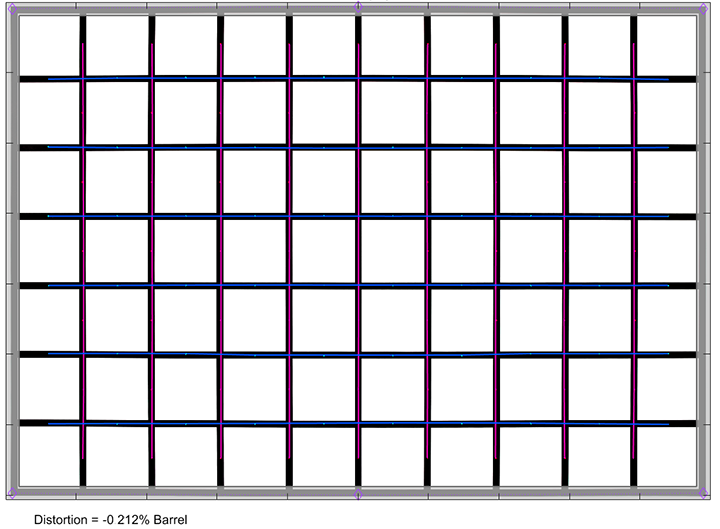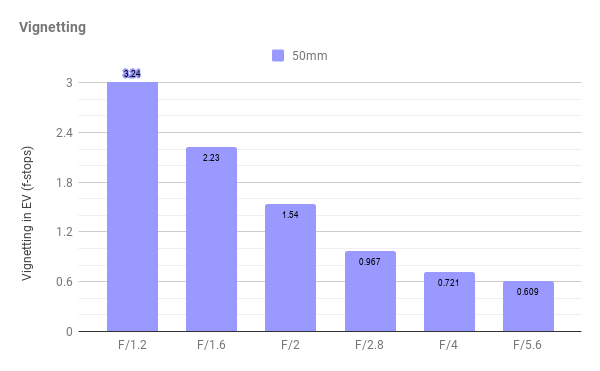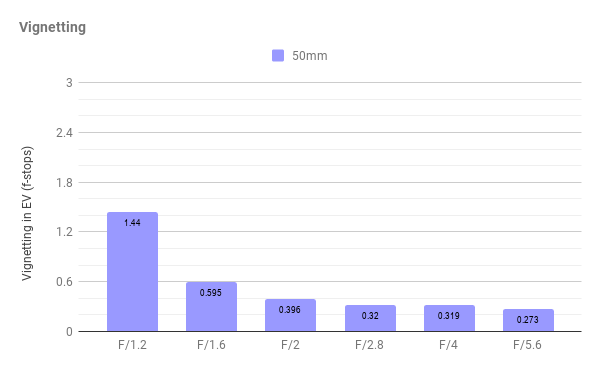|
Canon RF 50mm f/1.2 USM L - Review / Test Report - Analysis |
|
Lens Reviews -
Canon EOS (Full Format)
|
|
Page 2 of 3

Distortion
Fortunately, Canon did not follow the recent trend of relying on digital post-correction regarding image distortions. The amount of barrel distortion is very low (0.2%) and nothing to worry about.

Vignetting
Ultra-high-speed lenses produce quite some vignetting on full format sensors and the RF 50mm f/1.2 USM L is no exception to the rule here. At f/1.2 the vignetting exceeds 3EV (f-stops), which is, of course, easily visible. For some, this may be an issue, whereas others may actually prefer such an effect. Stopping down to f/1.6 and, more so, to f/2 reduces the issue substantially, albeit there's still some light falloff visible. Traces remain at f/4 and beyond.
 Of course, you can activate vignetting auto-correction on a Canon camera as well. If so, the vignetting is greatly reduced at f/1.2 and pretty much gone from f/1.6 already (at the cost of increased corner noise).
Of course, you can activate vignetting auto-correction on a Canon camera as well. If so, the vignetting is greatly reduced at f/1.2 and pretty much gone from f/1.6 already (at the cost of increased corner noise).

MTF (resolution) at 30 megapixels
The Canon EOS R is no megapixel monster at just 30mp, and the RF 50mm f/1.2 USM L is having that sensor for lunch. The center performance is already near the sensor's capabilities at f/1.2, and stopping down does improve the quality only marginally from here.
The near-center quality is almost as good. There is, of course, a bit of drop at the image borders/corners, but it's massively better than its older cousin, the EF 50mm f/1.2 USM L. here. The resolution in the outer image field is already very good at f/1.2 (just). The borders are receiving a boost to excellent levels at f/2, and even the corners can make it there between f/4 and f/5.6. Relevant diffraction effects don't set in prior to f/11.
The centering quality of the tested sample was very good. The field curvature is low.
Please note that the MTF results are not directly comparable across the different systems!
Below is a simplified summary of the formal findings. The chart shows line widths per picture height (LW/PH) which can be taken as a measure of sharpness.
If you want to know more about the MTF50 figures, you may check out the corresponding Imatest Explanations

Chromatic Aberrations (CAs)
Lateral CAs have an average width of around 0.5px at the image borders. In this megapixel class, that's pretty good and doesn't disturb, really.

Bokeh - Basics
Sharpness is one thing, but you really invest in such a lens for its bokeh capabilities (out-of-focus rendering). The results are - mostly - great again here.
Let's have a look at the quality of out-of-focus highlights first. In the image center, they are nicely rendered with a smooth inner disc. The circular shape remains intact at f/1.6, but you can already spot the first aperture edges at f/2. This is fairly "early" and quite surprising given the fact that the lens features 10 aperture blades.
 As far as the general blur is concerned, it's smooth both in the image foreground (to the right below) and background (to the left).
As far as the general blur is concerned, it's smooth both in the image foreground (to the right below) and background (to the left).

Bokeh - Cat's Eye
Starting with this review, we are also providing a "Cat's eye" test for high-speed lenses at least. As mentioned above, the out-of-focus highlight disc are quite nice in the image center, but they are (always) deteriorating towards the image corners This is vignetting effect due to the physical limits of the lens barrel. The image sequence below gives you an idea of how this effect starts at f/1.2 and how the border/corner highlights improve when stopping down.
Note: You may spot that the highlights have a graduated inner zone at f/1.2 and, a bit less so, at f/1.6. That's a flickering effect from the light source. At f/1.2, the shot was taken at 1/4000sec.
Bokeh Fringing
In a perfect world scenario, you won’t see any axial CAs, thus color fringing on the Z-axis. However, only a handful of fast lenses are correcting the issue effectively. The Canon RF 50mm f/1.2 USM L is actually ALMOST there.
At f/1.2, you should be able to spot the usual purplish color fringing in front of the focus point and a greenish halo beyond. However, the fringing is almost gone at f/1.6 already - which is very impressive.
You should also be able to notice that the focus point does NOT shift when stopping down when selecting different apertures below. Many high-speed lenses have difficulties keeping the focus point spot on. Technically, these focus shifts are called Residual Spherical Aberrations (RSA).
|